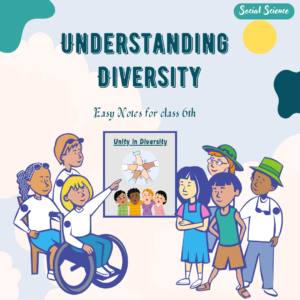Introduction:
Have you ever noticed how different your friends look, talk, and even dress? That’s called diversity, and it’s what makes our world so colorful and fun! In this chapter, we’ll learn about how people are different in many ways, like the languages they speak, the festivals they celebrate, and the foods they eat. Imagine how boring life would be if everyone looked the same, spoke the same language, and did the same things every day. Diversity brings excitement and new experiences to our lives. It helps us learn new things and understand different cultures.
What is Diversity?
Diversity means the variety and differences among people. It’s like having many different colors in a box of crayons. People can be different in how they look, how they talk, what they believe in, and what they like to do. It makes our world interesting because we get to learn from each other’s differences and enjoy different things together. Diversity teaches us to respect each other and helps us see how special everyone is in their own way.
What does diversity add to our lives?
- Diversity makes life more interesting with different foods, festivals, and friends. It teaches us about other cultures and helps us see things from new perspectives. When we respect and understand each other’s differences, our communities become more colorful and welcoming.
- Remember Samir Ek and Samir Do? They were friends from different places. You might have friends who are very different from you too. You might enjoy their food, celebrate their festivals, and even try on their clothes!
- Now, imagine if everyone looked the same, dressed in only red and white, ate only potatoes, and played the same game every day. Wouldn’t that be boring without diversity?
Diversity in India
India is very diverse! We speak many languages, enjoy lots of different foods, celebrate many festivals, and follow different religions. Even though we do things in different ways, there are also many things we do similarly. This diversity makes India special and interesting!
How do we explain Diversity?
- Long ago, people traveled to new places by ship, horse, camel, or on feet. They stayed there and mixed their old ways with new ones.
- They shared languages, food, music, and religions, creating something new. Regions became diverse because of their unique histories and how people adapted to where they lived, like near the sea or in mountains.
- People not only have different clothes and eating habits but also do different kinds of work.
- For Example: Rural people work in agriculture and traditional crafts, while urban (city) people work in offices, factories, and services like banking and healthcare, relying on markets for their needs.
- The nature of work also depends upon the geographical location.
- This is why, we see diversity almost in every region of the Indian States.
Let’s understand better about India’s diversity through the examples of Ladakh and Kerala.
Ladakh
- Ladakh, a mountainous desert in eastern Jammu and Kashmir, gets little rain and remains snowy most of the year.
- People rely on melted snow for drinking water.
- In Ladakh, residents raise sheep and goats for valuable pashmina wool, traded with Kashmir.
- They eat meat, cheese, and butter.
- Historically, Ladakh was a trade route to Tibet for textiles, spices, silk, and carpets.
- It’s known as Little Tibet, where Buddhism reached Tibet.
- Here, Islam arrived over four centuries ago, with a significant Muslim population.
- Ladakh has a rich oral tradition, including local versions of the Tibetan epic, Kesar Saga, sung by both Muslims and Buddhists.
Kerala
- Kerala, in southwest India, is surrounded by the sea and hills.
- It’s famous for spices like pepper, cloves, and cardamoms.
- Early traders, including Jews, Arabs, and St. Thomas, introduced Christianity.
- Moreover, Ibn Battuta, a famous traveler, noted the respected Muslim community here.
- Vasco da Gama’s arrival marked the European sea route discovery.
- Kerala practices Judaism, Islam, Christianity, Hinduism, and Buddhism.
- Here, Chinese fishing nets (“cheena-vala”) and utensils (“cheenachatti”) are local influences.
- The fertile land grows rice; people eat rice, fish, and vegetables.
Unity in Diversity
India’s strength comes from its diversity. During British rule, people from different backgrounds united to fight for freedom. Despite their differences, they worked together and went to jail together. The British thought they could divide Indians, but the people stayed united.
The Jallianwala Bagh Massacre
In Amritsar, a British general ordered soldiers to fire on a peaceful crowd, killing many. People of all backgrounds—Hindus, Sikhs, Muslims, rich, and poor—had gathered to protest. This tragic event inspired a song to honor those brave people who fought for freedom.
Songs and Symbols of Freedom
Songs and symbols from the freedom struggle remind us of our respect for diversity. The Indian flag, for example, symbolized protest against British rule. In his book “The Discovery of India,” Jawaharlal Nehru explained that Indian unity is internal and embraces a wide tolerance of beliefs and customs. Nehru introduced the phrase “unity in diversity” to describe India.
India’s national anthem, by Rabindranath Tagore, beautifully unites diverse regions, cultures, and languages. Have you noticed how it represents our unity under one flag? Isn’t that amazing?



please upload notes for all chapters of Social Science of Grade 6.
it would be a great help.
thanks
okay, Anonymous. I would try to provide you all notes of Grade 06 as soon as possible.
Please provide us all the chapters notes of sst for class6
Yes, Shreya. Just a few days to work on 6th class notes. You will definately get it. Thank you.